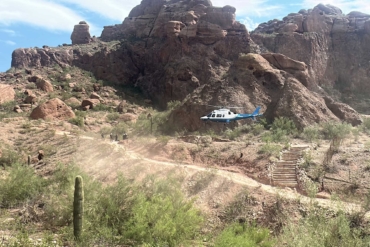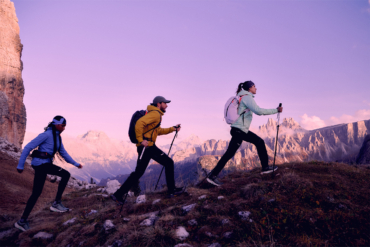With a little planning, city-dwellers can stretch their legs and get some much needed fresh air right out their front doors. Here’s the how and why to try out hiking in an urban area.
With gyms, crags, and trails closed, city hiking has seen a boom in the last few weeks. Across the country, more people are running and walking outside for exercise. Even the most restrictive stay-in-place measures still give walking the green light.
Although I’ve thru-hiked 20,000 miles of long trails and once held an Appalachian Trail FKT, I’m also a city hiker. I’ve spent the past 7 years designing and walking 200-mile backpacking routes in 14 cities.
Here’s why I did it even in times when hiking in nature was an option, and why it may be what you need right now to stay fit and sane.
But first, a word of caution: Please follow all local, state, and federal guidelines regarding COVID-19. And as these are changing nearly daily, do some research into the current regulations where you live.
In most places, this means bringing and wearing a mask even while practicing social distancing. Here’s a helpful place to start. Stay safe and healthy.
City Hiking: Discover Adventure Near You
Like many outdoor pursuits, city hiking is about setting goals, exploring new places, getting a workout, and being outside. Similar to hiking in nature, a side benefit is getting your mind to relax. Whether on a mountain or a sidewalk, hiking is a great way to forget about the worries of everyday life for a few hours.
Call it semantics, but I like to differentiate between “city hiking” and “going for a walk.” To me, a city hike has an element of discovery and surprise. You can’t do your usual loop around the block and call it a city hike (at least if you’ve done it a dozen times).
All forms of hiking take you places that are different from what you see every day. Urban hiking stimulates your brain to realize it’s doing something new. It’s a way to tell your brain that it needs to pay attention.
City Hiking Is Good for Mental Health
Hiking has always been about seeing the world at a human-powered speed — not the speed of a car. When we move at 3 miles per hour, our eyes, body, and brain operate at a pace where we can process our surroundings. In these times, being able to wrap our head around anything is a huge win.
When you go on a city hike, I want you to get lost. I want you to have to think on your feet. I want you to have to look around and navigate by eyesight.
Whether in nature or pounding pavement, doing new things is what expands our minds and keeps us nimble. In days of shelter in place, life can get monotonous. City hiking is a way to expand our world without venturing far from our doorstep.
That doesn’t mean that when you’re city hiking, you can’t visit a familiar place. Try walking to your grocery store. You may find the experience enlightening — or at least different enough that you’ll notice things you’ve never seen before.
I’ve discovered whimsical gardens and hidden pockets of nature on roads I blew past on my way to trailheads. With a shift of perspective, even the most boring suburban neighborhood can come to life with discoveries.
Who Can City Hike?
In the “Before Days” — before the pandemic, that is — I recommended city hiking to friends who don’t get excited about camping or getting muddy.
There are almost no bugs or wildlife encounters. No sleeping on the hard ground. You get a hot shower at the end of the day. It’s harder to get lost. Urban hikers almost always have a cell signal and phone GPS.
Tired or injured? It’s easy to call for a ride or take a bus home.
And city hiking doesn’t require as much gear as a trail hike. Grab a school backpack, some water, and sun protection. You’re ready to go.
Of course, these days, I’m dreaming of the day when I get to sleep among the mosquitoes and bears again. But city hiking has perks for dirtbags too. If you live far from a national forest or park, urban exploration is always open. I’ve city hiked through snowstorms in February. A similar trip in the backcountry would’ve taken a lot more skills, gear, and effort.
Like almost everyone right now, I’m grateful that parks, sidewalks, and stairways are still open. City hiking is a way to explore year-round.
Where Can I Go on a City Hike?
A lot of map nerds right now are poring over topos and guidebooks, designing routes for when we get out of this mess. For a city hike, you can take those same route-making skills and put them to use right now. Start with routes out your front door.
When you’re bored of that, drive to a nearby neighborhood and explore. Or take a left when you’d usually take a right to discover an entirely new route.
How to City Hike
- Choose a destination: Think of it as the “summit” of your city hike. Set your goal as a distant park, mural, or cafe.
- Map it: I use the free desktop Google My Maps, which integrates with the Google Maps phone app. Route your hike through residential areas. They’re often shadier, safer, and better for seeing fun things.
- Follow the “rules” of urban hiking: Never backtrack. Make loops, not out-and-backs. This forces you to see more and different places.
- Pack your gear: Bring water, snacks, a headlamp, sun protection, a first-aid kit (e.g., blister relief), and reflective, bright-colored clothing. Include your 100% charged phone, a backup battery, and paper maps.
- Wear the right gear: Pounding pavement impacts joints more than dirt trails. Wear supportive, well-cushioned shoes.
- Give yourself plenty of time: City hikes can be sensory overload. Even if you can hike 4 mph, you may not want to on an urban hike. Plan time to investigate random findings.
- Be open to change: Construction or road closures can force you to re-route. Paths or alleyways can become shortcuts. As on a cross-country route in the mountains, be open to moving with the landscape.
Give City Hiking a Chance
For 7 years, I’ve preached the virtues of city hiking to skeptical fellow thru-hikers. Every time I finally convince them to join, they’re surprised how fun it can be. Now that outdoorspeople everywhere face limited options, it’s time to give city hiking a chance.
Our health and sanity may depend on it.












